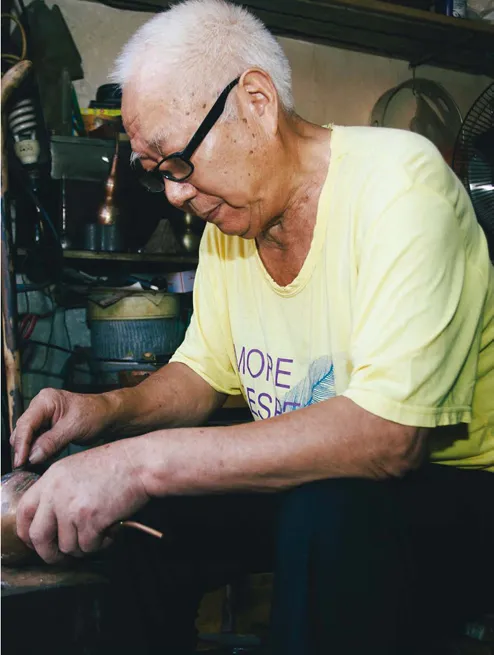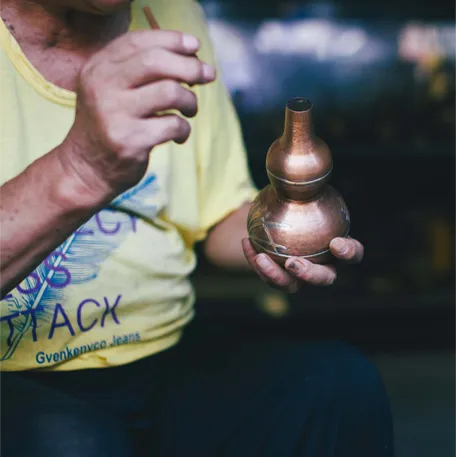The Inheritor of Intangible Cultural Heritage Generates Craftsman Genes
By Xu Kuang
The Inheritor of Intangible Cultural Heritage Generates Craftsman Genes
By Xu Kuang
W est Street deserves to be called the oldest business street in Hanyang District, Wuhan. It starts at the Guiyuan Temple on the left and ends at North Town Road on the right. “In the past, people in Hanyang would buy anything in West Street,even for a small button.” For the old generation,you can’t say that you visited Hanyang if you hadn’t been to West Street.
When exiting out of the Zhongjiacun Metro,you will see West Street overline bridge on the left. Walking inside the alley, there are eyecatching graffiti on the wall of the buildings, and rows of grocery stores where you can buy all kinds of daily necessities where you can strongly be immersed in the charming alley life there.
Half way into West Street stands a Copper Crafting Shop where the signboard of “Zeng’s Copper Shop” is yellowed with age. Quite different from the noisy and busy shops in the neighborhood, Master Zeng Xiangao, an 82-year-old man, is the only person working in the shop. He is polishing a 20-cm brass gourd with a small iron hammer.
A Young Apprenticeship
Mr. Zeng Xiangao, a cultural heritage inheritor in Wuhan, is a fourth-generation coppersmith.He started to learn the art of copper work from his father when he was 13 years old. They owned a copper ware shop on Hualou Street and then moved to Huangbei Street in Hankou. In those days, copperware was a necessity for every family—everyone had a brass kettle, bowl, and pan.
His father was very strict and had a bad temper. Being scolded and beaten was frequent for Zeng as he learned the art from his father. But it seemed that he was born to be a coppersmith. He was stubborn, patient, nimble, and smart.


西大街算得上是汉阳最早的商业街,左起归元寺,右接北城路。“当时年汉阳人要买颗扣子,都要到西大街来买。”在老辈人眼里,逛了西大街才算来过汉阳。
从钟家村地铁口出来,左望便是西大街天桥。走进西大街的小巷,围墙上的各式涂鸦夺人眼球;杂货店铺一家挨着一家,针头线脑都能买到,市井生活气息扑面而来。
西大街走到一半,便能看见一家铜艺店,“曾氏铜艺”的招牌已经发黄,与其他门前嘈杂的小商铺截然不同,店内只有82岁的曾宪高师傅一人,他拿着小铁锤打磨着一个高约20厘米的铜葫芦。
少年学艺底色
武汉非物质文化遗产传人曾宪高,是曾氏铜艺第四代传人。他13岁学艺,跟随父亲先后在汉口花楼街、黄陂街一带开设铜器店铺。那个年代,家家户户离不开铜制品,铜壶、铜碗、铜锅家家都有。
父亲很严厉,而且脾气暴躁。曾宪高小时候跟随父亲学艺,没少挨打。像是天生就吃这碗饭的,他有一股倔劲儿,熬得住,而且心思敏捷、头脑灵活。
有一次,父亲交待他做一个小铜艺,回来检查,认为他功夫不到位,气得把东西全部扔了出去。曾宪高捡回工具,默默重新开工。
学艺中的这些小事数不胜数,现在讲起来,曾宪高不禁感慨万千。“用现在的话说,这就是工匠精神,这门手艺,没有十年八年学不出来。”
过去,人们买的东西都讲究实用和耐用,对造型倒没有多看重。曾宪高跟父亲学着打造很多实用的器件,锅、壶、瓢、盘等,都是那个年月家家户户必备的生活用品。曾宪高记得自己做过一个锅底,换来两斤大米,高兴得不得了。
“过去,做得比较多的,一般是日常使用的生活用品,纯粹吃手艺饭,手工自然没话说。也有人专门找过来,定制艺术品,需要精心打磨。”
曾师傅说,老式火锅很常见,其工艺相对复杂,看着容易做起来难。火锅的形状上下连通,下面是炭室,上面是器皿,中间由一根烟囱状的管状物连通,底下可点火。小店的橱柜中还存有这样一个火锅,许久不曾使用,外表斑驳,落满灰尘,依稀能看出岁月的痕迹。
简单处见心思
曾宪高16岁出师,手艺日渐精湛。
20岁时,他到汉阳汽车改装厂做钣件工,厂里按评级来发工资,他被评为6级,月工资60元,而同期刚进厂的学徒工只有8元钱工资。
工作之余,曾宪高会做些小物件把玩。
1986年,他从厂里退休,搬到汉阳。他决定重拾手艺,在家门口摆摊,挂上“曾氏铜艺”的招牌。街坊邻居把破损的锅碗瓢盆都拿到曾老这里修补,顾客络绎不绝。
One day, Zeng’s father asked him to make a brass product. When checking it, his father thought that he didn’t get the essence of the work and threw his creations out of the room. Zeng just picked them up quietly and remade it patiently.
There were myriad trivialities like this in his apprenticeship. When recalling the past, Zeng said that, “This is the “spirit of craftsmanship” in modern terms. It is impossible for you to master the skill without eight or ten years’s practice.”
In those days, people valued quality and durability more than the shape and design when buying things.Zeng learned to make a lot of practical utensils from his father, such as pans, kettles, scoops, plates, and other household necessities. Zeng said he once made a pot base for which he exchanged 1kg of rice. He was very happy about it.
“I used to make articles for daily use.Craftsmanship is the most important thing for a product and my work is quite good. Some people came for artistic handicrafts which require meticulous polishing.”
Master Zeng said that the traditional hot pot was a common utensil, but it was actually very difficult to make because of the complicated craftsmanship involved.The traditional hot pot is made of a coal chamber at the bottom and a utensil on the top, which are connected by a chimney-shaped tube. The fire can be started at the bottom. Now a hot pot, lying silently in the corner of the closet, seems like faint remembrance of a distant time. For not being used for a long time, it is mottled and covered by dust.
Simple but Exquisite
Zeng served out his apprenticeship at the age of 16,and his skills were getting more and more refined.
At 20, he worked as a sheet metal worker in Hanyang Automobile Modification Factory where salary was decided by rank. He was ranked 6 and earned RMB 60 yuan per month, while his fellow workers only got 8 yuan.
Zeng liked to make some small items to amuse himself in his spare time.
In 1986, he retired from the factory and moved to Hanyang. He decided to restart the family business and opened “Zeng’s Copper Shop.” Knowing it,the neighbors at times took their broken kitchen utensils to his shop for mending and his business was gradually thriving.
“Do you think it’s easy to make this gourd? It’s rare to see a gourd made of a whole piece of copper.”Master Zeng held a brass gourd in his hand and said,“The simpler it looks, the more work it requires.” He summed up his experience of making this almostfinished brass gourd, which took him more than one month, “It is believed that gourds bring safety. A lot of families liked to buy gourd-shaped handicrafts in the past, but every line of the gourd tests the craftsman’s technique and skill. It’s even more difficult to make a brass gourd.”
When entering into Zeng’s shop, the first thing you will see is an eye-catching brass “Yellow Crane Tower.” Master Zeng said that it is made of 6.25kg of brass and is a miniature of the real Yellow Crane Tower, which is 100 times larger. With a delicate and exquisite design, there are 12 flying eaves on each floor and a plum-shaped button on each door. All the doors can be opened. It’s a masterpiece for Zeng. He cleans it every day so that every windowsill glistens.
“你说做这个葫芦简不简单?整铜打造的葫芦很少见。”曾师傅拿着手上的铜葫芦说,“越是看上去简单的东西,越得多花心思。”他对于手中耗时一个多月、即将完工的铜葫芦颇有心得,“在民间,葫芦有保平安的寓意,过去很多人家喜欢买些葫芦造型的摆件,不过葫芦的线条很是考验手艺,特别是铜制的,更难。”
来到曾师傅的店铺,进门就能看见的一个铜制“黄鹤楼”,很吸引眼球。曾师傅介绍,这座黄鹤楼用了6.25公斤的黄铜,按照黄鹤楼实物缩小100倍。每层12个飞檐翼角,梅花门按钮,每层楼的门都可以打开,精巧细致。这是老人的得意之作,他每天都会仔细擦拭,黄鹤楼的每个窗沿都亮亮的。
这件作品在2012年举办的湖北省非物质文化遗产保护专题中,荣获艺术设计比赛优秀奖,“曾氏铜艺”也被列为武汉市非物质文化遗产。
虽然街头车来人往,曾师傅心静如常,在8平方米的小天地里,与大锤、升锤、铁角板和拐针等20多种工具作伴。老人的铁砧子和铁脚板很有些年月,“已经传了三代,这些家什,市面上是买不到的。”
灵动的艺术品
曾师傅喜欢钻研,总在琢磨多做些新鲜物件。“你看这只虾,像不像真的?”曾宪高颇为自得,“我盯一只活虾一整天,装进心里才动手,无模具全靠心,一个月敲锤焊接而成,你看这虾钳,这些小麻点都费不少心思。”
“有一天在家午睡,我突然想到了藕,就跑到菜场观察藕的形态,回家我就用泥巴捏了个藕,街坊看后还开玩笑说,要拿回家炒了吃。”曾老笑着说。逼真的莲藕激发曾师傅的创意,他准备铜材料制作莲藕、莲蓬、莲花,觉得还有些单调,又制作了鱼和蜻蜓,整个作品全靠锤子把铜皮敲成各种弧度,耗时大半年的“荷塘秋色”就这样诞生。
十几年来,房间内慢慢摆满各种精致的铜艺品,有黄鹤楼、龙虾、金龙鱼、长嘴壶、酒壶等等。有人慕名前来高价购买,有人带着自家的铜制品前来让他烙上精致的图案。曾师傅说:“我好胜心强,基本没有我做不出来的样式。累点无所谓,客人对我作品的肯定,最让我感动、高兴。”
一件铜制品从选材到剪裁,经过不断敲敲打打,直至完成整个作品需要几个月甚至一年,费时又费力,长期手持钳子锤子做活,他的右手中指弯曲变形,从而练就精湛的手艺。
曾师傅的声名远播,2015年6月,有心人把曾宪高做的铜艺品拍摄记录成册,捐给俄联邦莫尔多瓦国立普希金图书馆。但是,他说:“现在做活多少有些力不从心,活计没有以前多,三个月前,有人远道过来,花500元让我给紫砂壶配一个盖子。”
说到高兴处,他拿出一把铜制二胡,它是曾师傅花3个月手工打造,淬火,锻造,都在店里完成。曾宪高当场拉了一曲,音色依然醇厚,引得街坊和过往的人过来围观。“这样的二胡全武汉很难找出第二把,上万块我都舍不得卖,我要自己留着。” ◆

灵心胜造物,妙手夺天工。传统手工艺,有代代相传的历史。
在机械化的冲击下,纯手工打造铜器的人越来越少。如今这门手艺很可能面临失传,曾老不免时常感慨:“我不知道还有多少时间能创作,我现在最大的心愿是有人能传承我的手艺,把铜艺发扬光大。只要有人愿意学,我愿意毫无保留免费教学。”
This handicraft won an Excellence Award in the Art Design Contest during the Cultural Heritage Protection Program held in Hubei Province in 2012.Zeng’s Copper Craftsmanship is listed as an intangible cultural heritage in Wuhan.
No matter how bustling the street is, Master Zeng is fully immersed in his world. In this eight square-meter shop,hammers, iron soles, needles, and other tools are his best companions. The anvil and iron sole has been used for a long time, “It has been handed down for three generations. You can’t buy these things in the market now.”
Inspirational Artwork
Master Zeng likes to learn and experiment on new things. “Look at this shrimp! Does it look like a real one?” Zeng was very satisfied about his work,“I observed a living shrimp for a whole day and started to make it when it was alive in my heart.I made it by heart instead of by mold. I spent one month striking, blowing, and welding the copper.You see the claw. It took me a lot of time to make the pock marks on it.”
“One day when I was taking a nap at home,I suddenly thought about lotus root. I ran to the market and observed the shape of lotus root, and made one with clay. Neighbors joked that it looked so real that they wanted to eat it.” Zeng laughed. The vivid lotus root inspired Zeng to make more copper artwork,such as lotus root, lotus seedpods, and lotus. He even made copper fish and dragonflies. All the works were done on a piece of copper sheet by hammering. That’s how the Autumn View of Lotus Pond came, which took him more than half a year.

In the past decade, the room has been gradually filled with different kinds of delicate copper artwork, including the Yellow Crane Tower,shrimp, arowana, long spout teapots, wine pots, and others. Some people came to purchase his work at a high price because of his fame, while others brought their own copper ware for him to inscribe beautiful patterns upon. Master Zeng said, “I am very ambitious. I can make almost any pattern. Getting tired is nothing for me. What makes me happy and proud is the recognition from my customers.”It takes several months or even one year to finish artwork, from choosing the raw material to the design and process. It’s a toiling job. Zeng’s right middle finger has become crooked from the repeated use of his pincer and hammer. This is how he has mastered the technique.
Zeng’s fame has also spread abroad. In June of 2015, an album of Zeng’s copper artwork was made and donated to Mordovia State Pushkin Library of Russian Federation. However, he said, “I am not as energetic as before and my output has reduced a lot. Three months ago, someone came for me to make a cover for his darkred enameled pottery with 500 yuan.”
He got excited as he took out a brass erhu, a two-stringed bowed musical instrument. It took him three months to weld, quench, and forge in the shop. He played one song with the erhu whose low tone attracted many neighbors. “You can't find another erhu like this in Wuhan. I would not sell it even if you gave me ten thousand yuan. I will keep it.” ◆
Zeng, with his creativity and craftsmanship, has been making exquisite artworks rivaling nature. However, no matter how excellent his craftsmanship is, it needs to be handed down from one generation to another.
Fewer and fewer people choose to be a coppersmith in this age of mechanical revolution.Whenever thinking that there may be no successor for this craft, Zeng would lament, “I don’t know how long I can keep making new creations, but my greatest wish is that someone can inherit my craftsmanship and further develop copper art. As long as they want to learn, I will teach them everything I know for free.”
非遗传人演绎工匠精神
文/许旷

